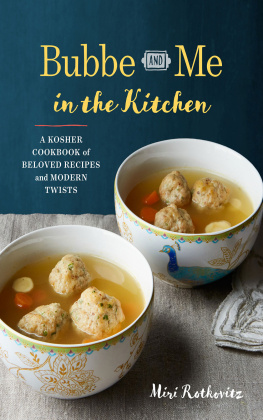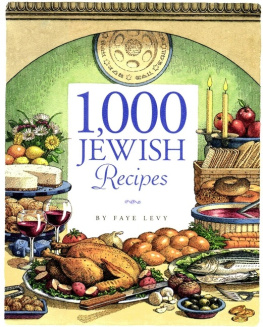
For my mom, and for Dana
CONTENTS

How does a half-Italian, half-Jewish girl from upstate New York become a challah expert and baker, and cookbook writer? I have reflected upon the unusual path my life has taken many times while putting these recipes together.
I have worked in restaurants and taken tons of recreational classes in knife skills and bread baking and cake decorating, but I am far from a chef. In fact, I started blogging about food and developing my own recipes primarily as a hobby almost 10 years ago, when I was working as a communications manager for renowned Jewish philanthropist Edgar M. Bronfman Sr., of blessed memory. But even before I began blogging and writing about food, my story truly started with baking challah.
When I was 16 years old my mother passed away from non-Hodgkins lymphoma, and suddenly I was de facto in charge of a 13-year-old (my brother Jon) and a 6-year-old (my sister Riana). To say I didnt know what I was doing would be an understatement, but I decided I was going to start baking challah on Thursday nights with my siblings. Even though my mother wasnt Jewish (she was a nice Italian Catholic girl from Brooklyn) and I had never ever seen her make challah, she loved baking and so being in the kitchen connected me to her. One day I opened up her copy of Beard on Bread and I started making challah.
For the first few years, I made a lot of bad challah. Challah that was burnt on the bottom. Challah that was raw on the inside. But I just kept making it, picking up tricks and techniques along the way, until it wasnt bad, until it was pretty good. Finally, I perfected my recipe and people started asking if they could buy their Shabbat loaves from me. I was proud of the beautiful traditional challahs I was now able to produce. But they didnt remain traditional for too long.
I found myself thinking about all the wild variations I could make. It started simple enough with ingredients like rosemary and garlic, dried cherries and olive tapenade. But I was now on a challah high and I wanted to try more combinations: challah stuffed with pastrami and Russian dressing; topped with frosting and sprinkles; and even baked around an entire wheel of Brie. My challah baking expanded to cookies, which led me to babka and rugelach and other types of bread, and then chicken soup and brisket, and well, you get the picture.
As my skills became more refined, and as I took on my current role as editor of the food blog The Nosher, I connected with other bakers and cooks from all over the world whose mixed stories resonated with my own. Their expertise further encouraged me to go beyond challah. I met Jennifer Stempel, a fellow baker and blogger, whose Jewban (Jewish + Cuban) creations of Latin-inspired brisket, challah, and matzah ball soup further inspired me to use my own Italian heritage in more of my creations.
I learned to make hamantaschen from Rachel Korycan and her mom Susan, a convert to Judaism, whose hamantaschen recipe was the best I ever tasted. Over the years I adapted her recipe, expanding and creating classic and crazy flavors for Purim each year.
I met Samantha Ferraro, a blogger from the West Coast, who taught me to make rugelach, a task with which I had previously struggled. Samantha, whose mother was Sephardi and father was Ashkenazi, was raised in Hawaii and later married a man of Italian descent. She mixes the diverse influences from her life into some of the most beautiful, colorful, and delicious creations. These are just a few of the creative women I have connected with over the years who are reclaiming and reinventing traditional foods with modern and multi-ethnic interpretations.
Bagels, pita, and matzah have been new additions to my baking repertoire. I must admit that I initially considered these baking tasks daunting, but once I started making my own pita, bagel, and matzah creations, I could never return to store-bought. Making these breads has become as addictive as my desire to create new flavors of challah.
A few years ago I was at a Jewish food event when a colleague came up to me and asked, What is it about challah for you? Why do you make so many different kinds? It was an interesting question, and one that I hadnt given much thought to before that moment. She went on to explain that she grew up eating the same traditional challah that her mom made every week, and now she happily makes the same plain challah every week for her own family. Of course there are many Jewish families who savor the taste of and the process of baking challah for the very fact that it is, in its original form, traditional and familiar. For them, challah is sweet in its simplicity. For me, however, maybe because my own history is not typical, I see challah as a way to merge old and new, and create something that is comforting but also unexpected.
My intention for this cookbook echoes my sentiment about challahI want it to both serve as a sort of baking map for you to master different types of dough and also be an invitation to be creative and diverse. These recipes are expressions of my not-so-uniquely mixed up American Jewishness; and they are inspired by my own Italian-Jewish upbringing, my many travels to Israel, and the many other mixed Jews I have known who mash up their different cultural identities into delicious, meaningful, and unique food.

We are in a wonderful moment in time when considering baked goods. No longer are we shackled to just one idea of what a bagel/challah/rugelach/babka must look and taste like. While I would like to consider myself a baking trailblazer, the trend of elevating and reinterpreting challah, rugelach, babka, and hamantaschen has been happening all over the country for some time: savory rugelach in Los Angeles, pulled brisket stuffed babka in Brooklyn, and red velvet challah in Boston, just to name a few. And thats not even mentioning the secular carb counterparts of cupcakes, croissants, doughnuts, and their many iterations.
The recipes in this book should serve as gentle guiding suggestions, but by no means are they precisely prescriptive and written in stone. There is no limit to the flavor pairings and combinations. Enjoy the toppings, fillings, and dough infusions I suggest in each chapter, but then have fun and play around with the combinations that most appeal to you. Master each dough, mix it up, and make it your own.
Pay attention to the list of tools at the beginning of each chapter and the type of flour, because these things do matter. In baking, one cannot skip steps; precision matters, and the right tools and ingredients can make the difference between something average and something extraordinary.
Keep in mind that the time of year can greatly impact dough, especially yeasted doughs like challah, babka, bagels, and pita. During the summer when it is more humid, recipes may require slightly more flour to achieve the same result youd get in a different season. In the winter, a recipe might need slightly less flour than normal. If your kitchen (like mine) is a bit cold, getting dough to rise easily might be a challenge. A warm oven provides the solution. Try a trick that several of my baking friends use: Warm the oven to 200F, turn it off, and then place dough (like challah, babka, or pita dough) in the oven so that it will rise more quickly.
Next page






